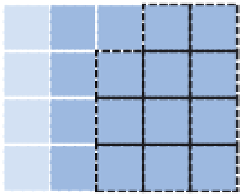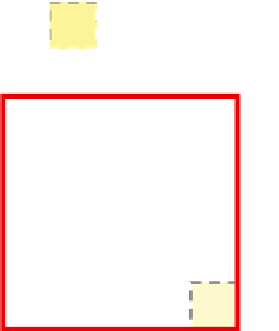Geography Reference
In-Depth Information
buffer (B)
τ
m
,
metatile
τ
m
,
metatile
_
n
Gain
metatiling
0 (no metatiling) 1454,10 ms 1454,10 ms 1
1 (metatile 3x3) 2933,94 ms 325,99 ms 4,46
2 (metatile 5x5) 5660,63 ms 226,42 ms 6,42
3 (metatile 7x7) 9561,54 ms 195,13 ms 7,45
Table 3.
Mean latencies to obtain an object from the WMS original service for different metatile sizes.
Proxy cache:
WMSCWrapper
; remote WMS: CORINE Land Cover.
The first column of the table shows the mean latency of a cache miss
τ
m
,
metatile
for different
metatile sizes. This delay includes the transmisission and propagation delays in the network,
the map image generation time in the remote web map service and the processing time in
the proxy cache. The values of the second column
τ
m
,
metatile
_
n
are computed by normalizing
those of the first column by the number of tiles encompassed by each metatile (
2
). The
last column shows the cache gain achieved by the use of metatiling, computed as the average
acceleration in the delivery of a tile versus not using metatiling, as depicted in Equation 1.
[
2
B
+
1
]
)=
τ
m
,
metatile
_
n
(
)
0
Gain
metatiling
(
B
(1)
τ
m
,
metatile
_
n
(
)
B
Results reflect that the latency involved in the request of a metatile increases with the buffer
size. However, it increases in less proportion than the number of tiles it is compossed by.
Therefore, the mean latency to obtain each individual tile decreases when increasing the size
of the metatile requested to the remote web map service. In other words, it is faster to retrieve
a metatile composed by
n
n
tiles than the
n
2
tiles individually.
×
'
i
'
j
Ca ched tile
Tijn
,,
Unca ched ti le
Requested tile
Figure 11.
Metatile selection algorithm.
A limiting factor when choosing the metatile size is the overhead in memory consumption
required to generate the map image. For example, by default the maximum amount of
memory that a single request is allowed to use in
Geoserver
is 16MB, which are sufficient to









































































